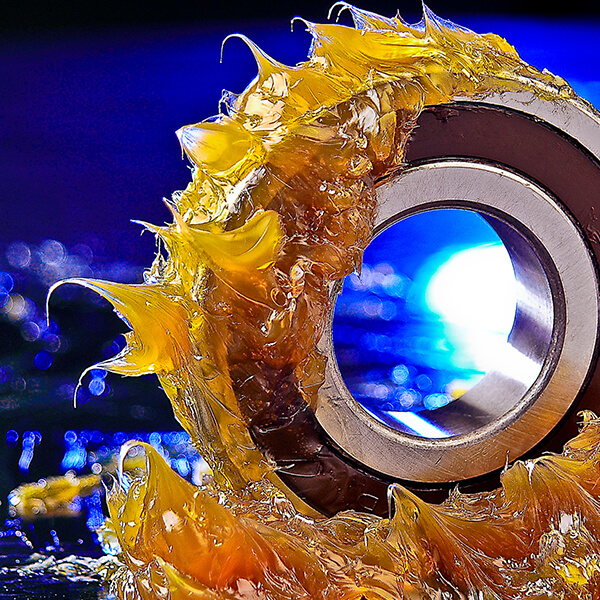The article is written by Riya Veluri, an editorial team member of Industrial Lubricants. After her graduation, Riya works as a website developer & SEO specialist in Lubrication & Tribology Industry & writes technical articles on Lubricants, Lubrication, Reliability & sustainability.
Semi Solid Lubricants
What are Industrial Lubricants?
Industrial lubricants comprise fluids, oils, greases (semi solid lubricants), and other substances which reduce wear, friction or eliminate moisture. Their primary purpose is to cover solid surfaces using a film. However, they can also be used to alter the properties of surfaces and regulate temperature.
What is Semi Solid Lubricant?
The essential semi-solid lubricants include grease, Vaseline waxes and other substances made up of fats and oil. They are semi-solid since they aren’t solids or liquids at average temperatures.
Lubricating grease consists of three components:
- Lubricating liquid (Base Oil),
- Performance-enhancing additives,
- Thickener.

The lubricating fluid could be petroleum-derived oil and various synthetic lubricating oils or vegetable-based oils. The lubricating oil is typically the main component of the grease formulation. The additives are usually used in small amounts in grease formulation and added to boost the performance of the semi-solid lubricants like grease. The thickener is what differentiates grease apart from liquid lubricants or oil lubricants. This ingredient gives the grease the characteristic of consistency, making it semi-solid, not liquid. A variety of chemical compounds can be utilized to make grease thicker.
Different types of thickeners are used to convert oil to grease or a semi-solid lubricant.
- Simple soap base,
- Complex soap base,
- Other kinds of a non-soap base
The soap-based greases are the most popular and more commonly used in the absence of high-temperature or high load applications.
A simple soap will employ only one acid, whereas two acids are utilized in complex soaps. If there are two acids, then it is a hybrid structure. There is a greater chance of sustaining high temperatures when there is a hybrid structure.
Therefore, complex soaps could be utilized for high-temperature applications, while simple soaps are suitable for low-temperature applications. The most widely utilized simple soap semi lubricant is calcium-based soap grease called multi-purpose grease. It offers temperature stability that can reach up to 65 degrees Celsius. Therefore, calcium grease works well and is often used in low-speed requirements. However, lithium grease also has excellent temperature stability as well as load carrying capacity and can be used as a complex series.

Thus lithium grease is mainly used for its standpoint of temperature stability and load carrying ability.
However, there is non-soap-grade grease, which is clay-based, mixed with solid lubricants.
In PTFE-based greases, PTFE reacts just like a solid lubricant. This class also has synthetic greases, polyurea ceramic paste, and alumina-silica gels. Sometimes, we categorize greases based on the additives it contains. One of the most well-known names for greases is molybdenum disulphide and graphite. The solid lubricant can be used to decrease the coefficient of friction.
The Functional Property of Grease
1. Grease is an elastomer to prevent leakage and block out contaminants. Grease functions as the sealant that prevents the leakage of lubricants and stops the entry of corrosive pollutants and foreign substances. It also keeps damaged seals in good working order.
2. Grease is much easier to store than oil. Lubrication of oil can involve both expensive circulators and complicated retention devices. However, grease can be very easy to contain with affordable retention devices because of its elasticity.
3. Grease holds solid lubricants suspension. The finely ground solids like molybdenum disulfide (moly) and graphite can be mixed into grease during high-temperature services or high-pressure applications.
4. The fluid level doesn’t have to be controlled or monitored.
The typical characteristics on the datasheets of products contain the following:
Pumpability:
The term “pump ability” refers to the capacity of the grease to be pumped or pushed through an apparatus. It is the ease with which pressurized semi solid lubricant can flow through nozzles, lines, and fittings of dispensing grease system.
Water resistance:
This is due to the capacity of grease to resist the effects of water without affecting its capacity to lubricate effectively. Lather from soap or water can cause the oil to be suspended in the grease, which creates an emulsion that can be washed off or, to a lesser extent, decrease oil lubricity through diluting and altering the texture and consistency of the grease.
Consistency:
The grease consistency is determined by the kind and quantity of thickener and viscosity of the base oil. The measure of consistency for grease is its resistance to deformation caused by an applied force. The measurement of consistency is known as penetration. Penetration will depend on how the consistency has been changed by handling or work. ASTM D 217 and D 1403 methods determine the amount of penetration of both worked and unworked greases. To measure the degree of penetration, a cone with a given weight is allowed to sink into the grease for five seconds at a standard temperature of 25 deg C (77degF).
The drop point
The dropping point measures the resistance capacity of heat by the grease. As the temperature of the grease increases, it increases penetration until the grease begins to liquefy, which means that its desired consistency disappears. The drop mark is where grease becomes sufficiently fluid that it can drip. The dropping point signifies the temperature where a substance can retain its shape and not necessarily the highest temperature at which particular grease can be used.
Stability of oxidation:
This is due to the capacity of grease to withstand a chemical bond with oxygen. The reaction of oxygen and grease creates insoluble gums, sludges, and lacquer-like deposits, which create a slow operation, increased wear, and a reduction in clearances. Exposure to prolonged temperatures increases the rate of oxidation in greases.
High-temperature effects:
The high temperatures that damage greases are more than they do oils. Grease, because of its nature, is unable to disperse heat via convection, like oil. Because greases have less capacity to remove heat, which can lead to accelerated oxidation or even carbonization in which grease solidifies. The effectiveness of grease lubrication is dependent on the consistency of the grease. Temperatures that are high cause bleeding and softening, which causes the grease to move away from the areas needed. The mineral oil found in grease may flash, burn or evaporate at temperatures higher than 177 degrees Celsius (350degF).
Low-temperature effects:
If the grease temperature is reduced enough, it can become so dense; it will be classified as hard grease. The ability to pump it out is reduced, and the operation of machinery could be rendered impossible because of torque limitations and power demands. For reference, the pourpoint is believed to be the limit at which grease can be used at its lowest temperature.
Applications which are suitable for Grease Lubrication
Oil and grease aren’t interchangeable. The choice of lubricant for a specific purpose is determined by comparing the specifications of the machine and its operating conditions with the desired properties of the lubricant. Grease is utilized when it isn’t practical or practical to use oil. Grease is typically used at:
- Equipment runs periodically or is in storage for a prolonged amount of time. Because grease can remain in the machine and lubricating films can form instantly.
- Machines those aren’t readily accessible to lubricate regularly. The best greases can be used to lubricate the parts that are isolated or difficult to access for prolonged periods without frequent replenishment. These greases can also be used for sealed-for-life purposes, like certain electrical motors and gearboxes.
- Equipment that operates in extreme conditions like extreme pressures and temperatures and shock loads or slow speed when under high loads.
- Grease helps maintain the thickness of the film in clearances that are increased due to wear and may prolong the lifespan of worn components which were previously lubricated using oil.
In this article, we have talked about the Lubricating greases, and we know that there are huge benefits of using lubricating greases, but there are certain applications are there where we need to use lubricating oils. So, both the greases and oils play an important role in reducing the friction of different applications and enhancing the overall life span of the equipment.



Be the first to comment